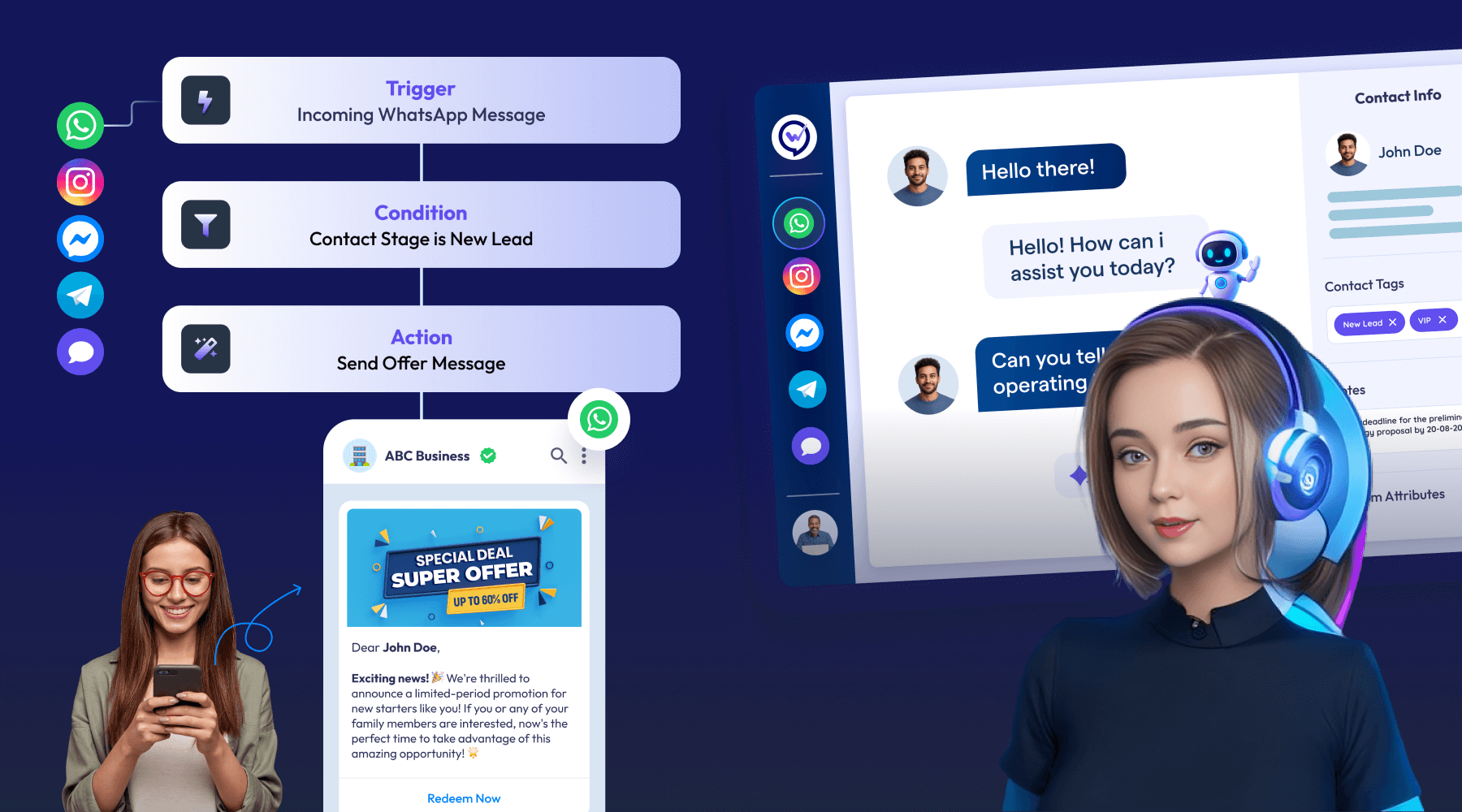Customer engagement has entered a new era. Businesses no longer rely solely on basic marketing automation software to push out scheduled emails or manage static campaigns. Instead, they’re embracing the combined power of AI chatbots and intelligent automation to create personalized, responsive, and real-time customer experiences. This shift moves us from fixed, rule-based systems to smart AI tools that learn and improve with each customer interaction.
In this article, we will discuss how brands use conversational AI, predictive analytics, and automation to create smarter, more personalized customer journeys and boost conversions. We will also cover integration best practices to help you thrive in today’s era of intelligent customer engagement.
The Power of AI Chatbots in Real-Time Engagement
AI chatbots have evolved far beyond basic scripted tools. Now powered by marketing automation software and natural language processing, they help businesses engage customers in real time and strengthen their online presence. These smart systems can start conversations, answer detailed questions, qualify leads, and book demos for fast and personalized support across multiple channels.
Here are the core functions of AI chatbots in real-time engagement:
- 24/7 Support With Context-Aware Responses. Modern AI chatbots offer round-the-clock assistance, so customers never have to wait for answers. They recall past interactions and user behavior to deliver timely and context-aware responses tailored to each customer.
- Natural Language Processing (NLP): Using NLP, AI chatbots understand not just what users say, but what they mean and how they feel. This allows them to interpret intent and respond empathetically. A chatbot detecting frustration in a message like “I’m sick of late deliveries” can apologize, prioritize the issue, and escalate it to a human agent if needed.
- Conversational Marketing: AI chatbots interact with website visitors through natural, real-time conversations. They offer tailored product suggestions, nurture leads, and guide users toward action.
- Qualifying Leads: AI-powered chatbots ask targeted questions to assess a lead’s needs, budget, and urgency. It automates a task that usually takes sales representatives’ time.
- Answering Questions: Whether it’s a simple FAQ or a complex policy explanation, AI chatbots provide immediate answers from vast knowledge bases. E-commerce brands use them to handle hundreds of product queries simultaneously to reduce response times and improve customer satisfaction.
- Booking Demos: AI chatbots simplify the demo booking process by syncing with calendars and managing availability.
Where AI Chatbots and Marketing Automation Intersect
Marketing automation software is vital for modern businesses looking to scale personalization and streamline customer engagement. In 2024, the global marketing automation industry is valued at $3.82 billion and is expected to reach $14.57 billion by 2033, showing its growing importance. As brands seek smarter ways to connect with customers, the boundaries between AI chatbots and marketing automation software are disappearing.
The best marketing automation software now enables real-time personalization, where every interaction triggers tailored workflows and decisions are driven by behavioral data. Here’s how the combination of these tools improves customer journeys and enables more agile and responsive marketing strategies.
Unified Data
Unified data forms the foundation of modern marketing automation, through personalized and highly targeted strategies at scale. AI chatbots capture real-time insights such as preferences, pain points, and customer intent during conversations. When combined with marketing automation software, this data improves customer journey mapping and helps marketers track behavior across channels.
A chatbot can track browsing activity and automatically update CRM records with real-time user insights. It will feed into automated workflows for drip campaigns, upselling, or re-engagement. Segmentation and targeting powered by AI then ensure that each campaign is timely, relevant, and tailored to the customer’s exact needs.
Triggered Actions
Triggered actions are where conversational insights turn into momentum. AI chatbots can automatically trigger marketing automation workflows based on user behavior or expressed interest. If a customer inquires about a product, the system can launch a personalized drip sequence. Along with that are tailored messaging, dynamic offers, or even a direct sales follow-up. This kind of real-time engagement reduces manual intervention, boosts responsiveness, and accelerates the path to conversion.
Lead Nurturing
AI chatbots are also essential for nurturing leads. Through natural conversations, they qualify prospects, uncover needs, and hand off valuable data to marketing automation software. This integration ensures that leads are placed into the right automated sequence based on their behavior or stage in the journey. Whether it’s onboarding content, promotional offers, or re-engagement messages, each step will be tailored to their needs. As a result, there will be a consistent, context-aware experience that builds trust and drives action at every touchpoint.
AI Chatbots and Marketing Automation Integration Best Practices
More than a connection between tools, integrating AI chatbots with marketing automation creates a seamless and responsive customer experience. With the global chatbot market valued at $7.76 billion in 2024, it’s clear that businesses are investing heavily in this technology to enhance real-time engagement. When done right, this combination boosts efficiency, personalization, and ROI.
Here are the best practices to help you create a smart and scalable system that delivers meaningful results.
Choose Compatible Tools
Integration success starts with selecting tools that work well together. Incompatible systems create friction, limit automation, and lead to data gaps.
What You Can Do:
Choose chatbot and marketing automation software that offer native integrations or open APIs. Use tools to sync real-time data like lead scores, conversation history, and engagement behavior. Ensure the tools also support CRM integration and multi-channel deployment for consistency across touchpoints.
What It Offers:
This seamless connectivity reduces manual work, improves data accuracy, and enables faster follow-ups. It creates a unified customer profile that helps teams deliver more relevant, timely messages for better engagement and conversions.
Start Small
You don’t need a full-blown chatbot strategy on day one. Start small to minimize risks and make it easier to learn and adapt.
What You Can Do:
Pilot a chatbot with a narrow focus, like qualifying leads on a single landing page or automating appointment scheduling for demos. Ask a few targeted questions to collect actionable insights without overwhelming users or your team.
What It Offers:
This approach allows for quick wins, manageable testing, and agile optimization with marketing automation software. You reduce complexity while still collecting valuable data that can guide broader automation strategies later.
Train Your Bot
A well-trained bot delivers accurate, useful, and human-like responses. Without proper training, it can confuse or frustrate users.
What You Can Do:
Feed your chatbot real customer queries, conversation logs, FAQs, and product details. Use your brand voice and industry terminology. If users frequently ask about Salesforce integration, teach the bot to respond with a helpful answer and a direct link to documentation. You can also continuously review and update scripts as products and campaigns evolve.
What It Offers:
A well-trained bot enhances user experience, minimizes handoffs to human agents, and fosters customer trust. It becomes a reliable touchpoint that handles complex queries, which makes your support and sales teams more efficient.
Track Key Metrics
Without metrics, there’s no way to tell what’s working. Keep monitoring chatbot performance for long-term success.
What You Can Do:
Track KPIs like conversation completion rates, drop-off points, lead conversion, CSAT scores, and response times. Use tools like Google Analytics to visualize patterns. If you notice a high drop-off rate at a specific question, revise the flow or reword the prompt.
What It Offers:
These insights let you optimize interactions, increase conversion rates, and improve customer satisfaction. Data-driven decisions ensure your chatbot becomes smarter and more valuable over time.
Boost Conversions Using Smart AI Chatbots and Marketing Automation
Smart AI chatbots paired with marketing automation software are revolutionizing customer engagement by delivering faster, more personalized interactions. With this synergy, you can expect real-time responsiveness, adaptive workflows, and the use of alternative data to fine-tune targeting and drive higher conversions. Start using this approach now to create smooth and scalable customer experiences. Use the right tools today to boost engagement, increase ROI, and prepare your brand for a data-driven future.
No strings attached! Try Whautomate now!
Start Your 7-Day Free Trial
Boost your Sales and save countless hours with Whautomate!
- Free 7-day trial
- No credit card required
- Support 24/7
- Cancel anytime

